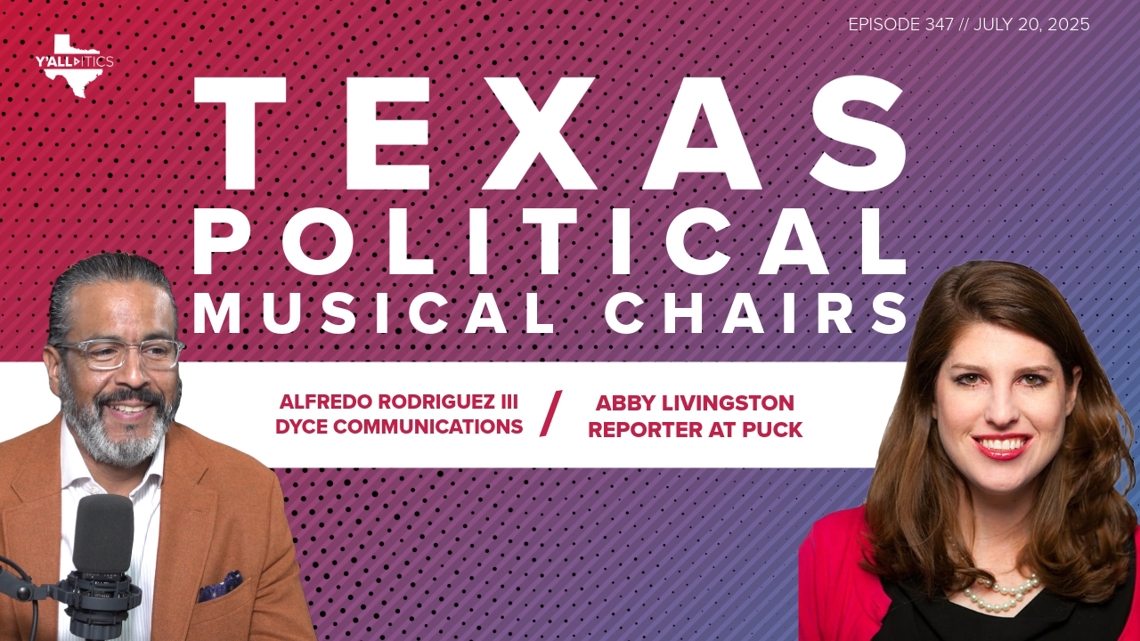
As Republicans prepare to tackle congressional redistricting during the special session, Democrats weigh their options.
TEXAS, USA — If you are looking for bipartisanship inside the Texas Capitol during the special session, you better hurry.
Lawmakers will immediately begin tackling flood-related legislation in the aftermath of the tragic July 4 Hill Country flooding. And there appears to be wide consensus to act.
But after that, you’ll be hard pressed to find agreement on the other agenda items, 18 total, but none more controversial than congressional redistricting.
“It’s a really good time, if you’re a Texas member of Congress, to have friends in the state legislature and it’s really causing some anxiety,” Puck reporter Abby Livingston told us on Y’all-itics.
Abby Livingston is an award-winning reporter and expert on political campaigns and Congress. Before joining Puck, Livingston worked for the Texas Tribune in Austin.
Redistricting usually occurs at the start of a decade when new census data is released. Changing the map mid-decade is unusual but has been done before.
Part of the risk is that old data is being used to carve out new districts, which can backfire on the party changing the maps.
Livingston said that simple fact has unnerved many Texas Republicans.
“Traditionally, the Texas Republican delegation has been such a lockstep group of people that no one ever bullied them around. And they seem very unhappy with this prospect, but they’re going along with it anyway, at least publicly, with a smile on their face,” Livingston explained. “And the reason they’re reluctant is that in order to draw five competitive seats or endanger five Democrats, you’ve got to pull Republicans from other districts and it’s really scaring some folks.”
Alfredo Rodriguez III is a longtime veteran of Republican politics in Texas and across the country.
Rodriguez was Regional Political Director for the National Republican Congressional Committee during the 2004 election. He helped lead then-Texas Gov. Rick Perry’s successful reelection campaign in 2006. And Rodriguez even served as a legislative aide for U.S. Sen. Kay Bailey Hutchison and U.S. Rep. Henry Bonilla.
Rodriguez is now the Founder/President of Dyce Communications, a strategic communications, marketing, and advertising firm.
The political insider said the idea of Republican voters being peeled away from one district and placed in another doesn’t scare him. He argues the winning margins for Republican congressional candidates during the last election were simply too large for the movement of voters to matter that much, and districts can afford to give away some of those votes.
Instead, he worries things may have gotten too easy for Republican candidates.
“What I would fear more than anything is that there are a lot of members in the Texas delegation who haven’t run a tough race in a long, long time, who don’t raise money as well as they should, who continue to rest on their laurels,” said the Republican operative. “Their constituent services are probably lacking because they have a safe Republican seat and have probably used consultants that continue to run the same cookie cutter campaign that got them elected the first time. And those members of Congress need to be more worried about that.”
Texas’ political map just changed in 2021, delayed, in part, by COVID.
At that time, Texas Republicans wanted to solidify their gains. The state also added two Congressional seats because of population growth, and Republicans wanted to make sure the GOP held them. Republicans have won 25 of 38 congressional seats since.
But that map has also been challenged in court, with plaintiffs arguing that it discriminates against Black and Hispanic voters. That trial just ended in May but has yet to be decided.
Some political experts say that case may now become moot if Texas changes its map once again.
President Donald Trump has said he wants five new Republican-held Congressional seats in Texas, and it can be done by simply redrawing the state’s political map.
Rodriguez said five seats is ambitious, but possible. He thinks four is more realistic.
Most experts agree it will be easiest for Republicans to pick up a couple of seats in South Texas, specifically Congressman Henry Cuellar in the 28th District and Congressman Vicente Gonzales in the 34th.
In the Houston area, there’s been talk about the 7th District held by Democrat Lizzie Fletcher, Congressman Al Green’s 9th District, or even the 18th Congressional District, which was held by Sylvester Turner until his death in March. A special election to fill that seat will be held in November.
In North Texas, the redistricting discussion appears to center around Congressman Marc Veasey’s 33rd District, or U.S. Representative Julie Johnson’s 32nd District.
Both Livingston and Rodriguez say Democrats are, in essence, powerless to stop redistricting.
“This is going to happen. They may try to shirk their responsibilities as elected officials and skip town maybe for a week or two weeks, not have a quorum so that they can go ahead and vote on the new maps,” Rodriguez argued. “But ultimately they’re going to have to come back and take a tough vote and that tough vote is going to result in new districts for Republicans.”
Abby Livingston said Democrats fleeing the state, something they last did in 2021, would have its own unintended consequences.
But in the end, there’s just not much they can do to stop redistricting.
“It’s almost like a game of musical chairs, and we’re all just kind of waiting to see who doesn’t get a seat,” Livingston said.
